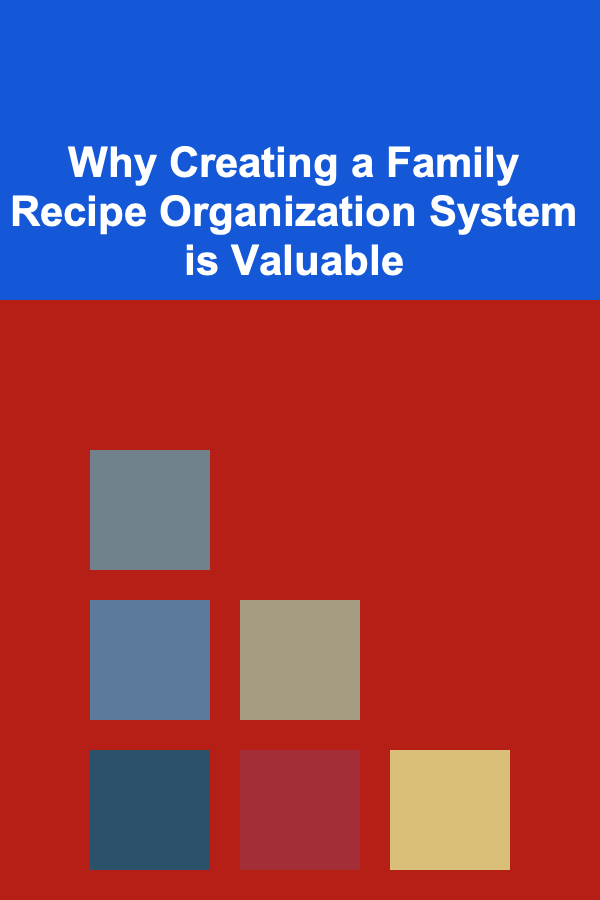
Why Creating a Family Recipe Organization System is Valuable
ebook include PDF & Audio bundle (Micro Guide)
$12.99$9.99
Limited Time Offer! Order within the next:

In today's fast-paced world, family traditions often take a back seat to the demands of everyday life. One of the most cherished traditions in many households is cooking together and sharing recipes that have been passed down through generations. However, as families grow and evolve, it can be challenging to keep track of these treasured recipes. This is where a family recipe organization system comes into play. By creating a structured method for organizing and preserving family recipes, you not only ensure that these culinary traditions are passed down but also foster family bonds and create lasting memories. In this article, we will explore the value of establishing a family recipe organization system, the benefits it provides, and practical steps for implementation.
The Importance of Family Recipes
1. Cultural Heritage
Family recipes are more than just a list of ingredients and instructions; they are a reflection of cultural heritage. Each recipe tells a story about the family's history, traditions, and values. From the spices used to the cooking methods employed, these recipes connect us to our ancestry and help preserve cultural heritage for future generations.
2. Strengthening Family Bonds
Cooking together is a wonderful way to bond with family members. When preparing meals as a group, stories are shared, laughter fills the kitchen, and new memories are created. A recipe organization system allows family members to contribute their favorite dishes, encouraging collaboration and fostering a sense of belonging.
3. Emotional Connection
Certain recipes are tied to significant life events, such as holidays, birthdays, and family gatherings. These dishes evoke nostalgia and create emotional connections among family members. By organizing and preserving these recipes, you ensure that these memories remain alive and accessible.
4. Culinary Education
A well-organized recipe collection serves as an educational tool for younger family members. Teaching children how to cook using family recipes instills valuable life skills and encourages them to appreciate their heritage. It also empowers them to experiment in the kitchen, fostering creativity and confidence.
Benefits of a Family Recipe Organization System
Creating a family recipe organization system offers numerous benefits beyond simply keeping track of dishes. Here are some of the key advantages:
1. Easy Access to Recipes
An organized system makes it easy to find and access recipes when needed. Instead of rummaging through stacks of papers or scrolling endlessly through digital files, a systematic approach allows you to locate recipes quickly, saving time and effort.
2. Preservation of Family Traditions
Without a proper organization system, beloved family recipes can easily be lost or forgotten over time. By documenting and preserving these recipes, you ensure that they are passed down through generations, maintaining family traditions and legacies.
3. Encouragement of Family Contributions
A recipe organization system invites all family members to contribute their favorite dishes, making everyone feel included. This collaborative effort enhances the collection and strengthens family ties, as each member has the opportunity to share their culinary experiences.
4. Customization and Adaptation
With an organized recipe system, it becomes easier to adapt and customize recipes according to dietary restrictions or personal preferences. You can note substitutions and variations, allowing recipes to evolve while retaining their original essence.
5. Streamlining Meal Planning
An organized recipe collection simplifies meal planning. By having a clear view of available recipes, families can plan meals more efficiently, reduce food waste, and save money by utilizing ingredients on hand.
6. Creating a Legacy
An organized family recipe system serves as a legacy for future generations. It becomes a tangible representation of your family's love, culture, and history, allowing descendants to connect with their roots and continue the tradition of cooking together.
Steps to Create a Family Recipe Organization System
Creating a family recipe organization system can be a rewarding project that brings family members together. Here are practical steps to implement this system effectively:
1. Gather Existing Recipes
Start by collecting all existing family recipes. This may involve searching through old cookbooks, handwritten notes, family emails, or even asking relatives for their contributions. Encourage all family members to participate in this step to ensure a comprehensive collection.
2. Decide on a Format
Once you have gathered the recipes, decide on an organizational format. Consider the following options:
a. Physical Recipe Box or Binder
A traditional recipe box or binder can be a charming way to organize physical recipes. Use dividers to categorize recipes by type (e.g., appetizers, main courses, desserts) and ensure that each recipe is written or printed clearly.
b. Digital Recipe Management App
For tech-savvy families, using a digital recipe management app can streamline the organization process. Many apps allow users to categorize, search, and share recipes easily, making it simple to access them from various devices.
c. Shared Online Document
Creating a shared online document (e.g., Google Docs) can facilitate collaboration among family members. Everyone can contribute their recipes, make comments, and suggest modifications in real time.
3. Categorize Recipes
Organizing recipes into categories helps streamline access. Consider the following categories:
- Main Dishes
- Side Dishes
- Appetizers
- Desserts
- Beverages
- Special Occasion Recipes
Feel free to add or modify categories based on your family's preferences.
4. Standardize Recipe Format
To maintain consistency, standardize the format for each recipe. Include essential details such as:
- Recipe name
- Ingredient list
- Step-by-step instructions
- Cooking time
- Serving size
- Occasion or context (e.g., holiday, family gathering)
Standardizing the format makes it easier to read and follow the recipes.
5. Document Family Stories
Encourage family members to include personal anecdotes, stories, or memories associated with each recipe. This adds depth and richness to the collection, creating a narrative that goes beyond mere instructions.
6. Consider Dietary Restrictions
Incorporate notes on dietary restrictions or modifications for each recipe. This ensures that everyone in the family can enjoy the dishes, regardless of allergies or dietary preferences.
7. Regular Updates
Make it a habit to regularly update the recipe collection. Encourage family members to share new recipes they discover or to document any changes made to existing recipes. This keeps the collection dynamic and relevant.
8. Plan Family Cooking Sessions
Organize family cooking sessions where everyone can come together to prepare a recipe from the collection. This not only reinforces the bonds within the family but also provides an opportunity to teach younger members about cooking and the significance of the recipes.
9. Share the Collection
Once the organization system is established, consider sharing the collection with extended family members. This can be done through print copies, digital formats, or even a dedicated family website. Sharing the collection fosters a sense of community and allows others to contribute their own recipes.
10. Create a Family Cookbook
As an exciting culmination of your efforts, consider compiling the organized recipes into a family cookbook. This can serve as a cherished keepsake for generations to come. Include photos, family stories, and illustrations to make the cookbook visually appealing and meaningful.
Conclusion
Creating a family recipe organization system is a valuable endeavor that transcends mere cooking. It preserves cultural heritage, strengthens family bonds, and fosters emotional connections among family members. By establishing a structured approach to organizing and documenting recipes, families not only keep their culinary traditions alive but also create a legacy that future generations can cherish.
The process of gathering recipes, categorizing them, and sharing stories fosters collaboration and inclusivity, allowing every family member to feel connected to their culinary heritage. As you embark on this journey, remember that the heart of cooking lies in the joy of coming together, sharing experiences, and creating lasting memories.
Whether you choose a traditional recipe box, a digital app, or a combination of both, the key is to create a system that works for your family. So gather your loved ones, roll up your sleeves, and start building a family recipe organization system that will stand the test of time. Your family's culinary legacy awaits!

How to Create a Budget-Friendly Home Security Plan Using Bosch Security Systems
Read More
How to Create a Home Management Binder for Organization
Read More
How to Create a Shared Office Supply Station
Read More
How to Make Money Online as a Tax Preparer: 10 Actionable Ideas
Read More
How to Organize Your Goals with Mindfulness Principles
Read More
Top Affordable Alternative Transportation Options to Save Money on Travel
Read MoreOther Products

How to Create a Budget-Friendly Home Security Plan Using Bosch Security Systems
Read More
How to Create a Home Management Binder for Organization
Read More
How to Create a Shared Office Supply Station
Read More
How to Make Money Online as a Tax Preparer: 10 Actionable Ideas
Read More
How to Organize Your Goals with Mindfulness Principles
Read More